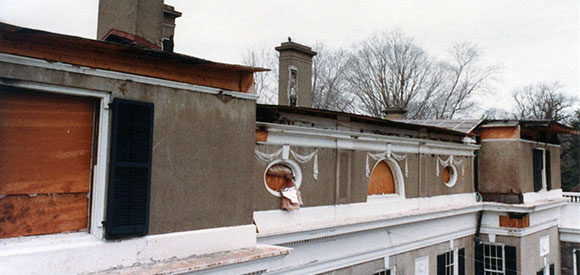Many threats make managing our cultural resources challenging, but perhaps none is more terrifying than fire.

I will never forget the time when I first saw the “Ghost Shirt” on display at the Badlands National Park visitor center. Here was an actual garment worn by a Lakota Sioux, which was believed to guard against bullets through spiritual power, or at least protect the wearer enough to resist white encroachment onto the last bastions of tribal land. Unfortunately, on a cold day in December 1890, the garment didn’t stop more than 153 Lakota Sioux from being killed by a detachment of the U.S. 7th Cavalry Regiment near the Wounded Knee Creek in South Dakota. That single piece of clothing was essential to telling a pivotal moment in our collective history and experience.
Ask yourself, what draws you to visit a National Park Service site? Is it the natural beauty, the geologic formations, a historic structure, an archeological site, a remarkable event, or simply recreation? The piece that bonds all of these elements together is the cultural connection. In fact NPS stewardship of cultural resources perpetuates all of these elements and allows for our continued appreciation, understanding, and enjoyment.
Many threats make managing our cultural resources challenging, but perhaps none is more terrifying than fire. In just minutes, a fire could destroy everything, leaving us with nothing but historic ashes. Sites like the Waterside Theatre complex at Fort Raleigh National Historic Site and Fort Clatsop at Lewis and Clark National Historical Park have burned in structural fires. Perhaps the most unfortunate example was the 1982 fire at Home of Franklin Roosevelt (HOFR).
Just days before the park was to celebrate the 100th birthday of Franklin D. Roosevelt, an electrical fire started on the third floor, which was being rewired. A fire detector went into alarm mode around 12:15 a.m. Firefighters responded and were taken off guard because the home had a long history of false alarms.
Arriving units found heavy fire coming from the roof and the third floor of the structure. In addition to battling the fire, firefighters and park employees had to rush throughout the house attempting to save as many of the historic and cultural artifacts as they could without causing undue harm to themselves.
It was reported that a park curator tossed a tarpaulin over the bed in which Roosevelt was born on January 30, 1882, another curator pulled a delicate Dresden chandelier from the ceiling just moments before the fire department ordered the room evacuated for fear of the ceiling collapsing, and yet another NPS employee reported seeing a teddy bear from the third floor float “down the stairs to the first floor.” The curator told reporters, “You take such pride in the home and your job; to have something like this happen is a terrible disaster.”
The New York Times reported that water “cascaded down the staircases” and collected on the other floors to a depth greater than one inch where it froze. In the end, nearly 250 firefighters from 10 area departments were called to battle the blaze, which continued to flare up for hours. Firefighters had to cut through walls and ceilings to reach burning insulation and to search for hidden spot fires for hours before the fire was finally extinguished.
For the park superintendent, the fire occurring so close to the anniversary was devastating. “It was worse than the worst nightmare,” said Dixon Freeland, the park superintendent. “There was a moment there when it seemed as if we’d lose the whole thing.”
“Most changes come about following a significant loss,” reports Joe Mazzeo, the Northeast Regional (NER) Structural Fire Program manager. Following the fire, a $2 million special appropriation by Congress was passed to handle reconstruction efforts. Between the damage and the potential loss of so many irreplaceable cultural resources, the region launched a comprehensive program to ensure that this would never happen again. As a result, the NER was the first region to establish a regional structural fire program manager position. The initial intent of this newly established position was to assist parks with the development of park structural fire management plans. However, it soon became apparent that there was a much broader need to help parks develop comprehensive fire and life safety programs to meet their structural fire responsibilities.
The National Park Service has more than 1,330 historic properties and a museum collection containing more than 105 million items. The NPS cannot underestimate the threat of structural fires to our cultural resources, let alone the risk to employees and visitors. “Fire Prevention Week reminds us how serious the threat is and how damaging the consequences can be,” reports Harold Spencer, the NPS Structural Fire Branch chief. Due to proper planning, the National Park Service has had successful saves, such as Bryce Canyon Lodge in 2009, and more recently, the Wayside, Home of Authors in Minute Man National Historical Park. “When we collectively work together, across disciplines and with park and regional management, we can ensure that our national heritage can be passed down to not only the next generation but the generation to follow.”
Help us protect our ghosts so we can share their memory and legacy with the generations to come.
Tags
- home of franklin d roosevelt national historic site
- minute man national historical park
- structural fire
- fire prevention
- fire prevention week
- fire suppression
- cultural resources
- fire history
- heritage preservation
- home of franklin d roosevelt national historic site
- minute man national historical park
- the wayside home of authors
- bryce canyon national park
- ner
- imr
- cultural resource management
- historic ashes
Last updated: July 9, 2020
